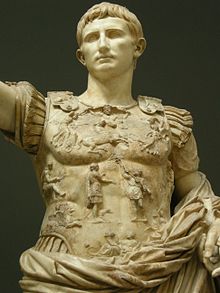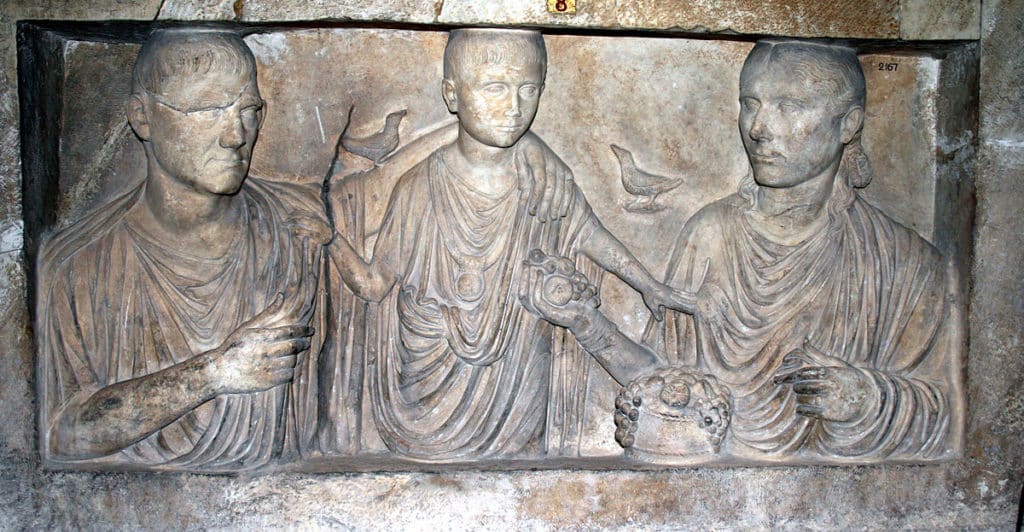Building program
One way that Augustus showed Pietas religio, is through the building program. This is done in a fashion that ended up paying off brilliantly for Augustus, securing his name in the history books.
To begin with, we hear in The Deeds of the Divine Augustus, that “he built: the temples of Mars, of Jupiter Subduer and Thunderer, of Apollo, of divine Julius, of Minerva, of Queen Juno, of Jupiter Liberator, of the Lares, of the gods of the Penates, of Youth, and of the Great Mother, the Lupercal, the forum of Augustus, the Octavian portico, and the grove of the Caesars across the Tiber.”
He rebuilt many for the gods, including two for Jupiter and one for Apollo, Vesta and Mars, and also rebuilt the senate-house and built the Forum Augustus. While this is written in a way that makes him seem like a great and religious man, this can also be seen, perhaps more accurately, as propaganda. The people of Rome would see Augustus rebuilding the temples as a reflection of his religious reforms and his pietas, which were major for propaganda value.
Prima Porta
Another way Augustus shows Pietas religio is through the Prima Porta. The Prima Porta was a statue of Augustus, which is seemingly far more than just a statue. Augustus’ statue is standing in a relaxed pose, where one of his legs holds his weight, is wearing a military uniform and his right arm is outstretched. This immediately defines him as a leader and a military conqueror.
Another significant feature in this statue, is that he has a cupid riding a dolphin next to his right leg. This is symbolic of him being descended from the Gods. Cupid is the son of Venus, the Goddess of Love. Julius Caesar, the adoptive father of Octavian claimed to be descended from Venus himself, giving Augustus the same connection. Finally, there’s the breastplate.
Around the center of this are Gods and personifications. On the sides of the breastplate are the female personifications of the countries that Octavian has conquered. The gods and personifications are to show Pax Romana, the long-time of peace and stability he had given Rome. Beneath the female representations are the two deities, Apollo and Diana.
Clearly, Octavian was favored by these deities, and showing these here show the support of traditional Roman religion. The entirety of this statue is supposedly a major symbol of the religious pietas, but, it was likely to simply be a statue of propaganda.
Mos Maiorum
When it comes to Octavian preserving the old ways of Rome, he was very open and supposedly noble about his approach, with his main basis being moas maiorum. Unfortunately, along with the majority of the concepts that Octavian applied to Rome, it was for self-benefit.
According to Alison Morton; “The mos maiorum could be evoked to validate social developments in the name of tradition. Following the collapse of the Roman Republic after the death of his adoptive father Julius Caesar, the ever-astute Octavian disguised his radical program as piety toward the mos maiorum on his way to becoming the powerful individual, Augustus.”
According to himself, Augustus believed that going back to the older ways of Roman times would be the best way to fix Rome. His system was to not let Rome stray too far away from its original roots. However, as Alison states, this is a disguise for his true objective; to show himself in a certain light.
This does not mean that he did not believe certain things he was promoting, it simply shows the bigger picture. Octavian, with the power that he had, had no interest in ending up with the same fate as his predecessor. Z.Yavetz states that “He was traditional and conservative, preferring to see his children dead than see them live in moral disgrace.
He believed that the commonwealth of Rome rested on ancient customs and men of virtue” Z.Yavetz shows a certain side of Octavian, that while perhaps is the same opinion the Romans had, is most likely speaking from the perspective of someone who believes in the propaganda. The biased view that he puts forward is undeniably clever in the sense that nobody could go against his word, believing that the old ways were what Octavian supported.
Ignoring the Gods
One major point that Augustus made for Rome was that they had been ignoring the Gods. Rome had come through multiple terrible civil wars. Augustus blamed this on the fact that the Romans ignoring a lot of their gods. Multiple priesthoods remained empty and forgotten, and temples had fallen into disrepair. Augustus believed that by reviving these, he would bask in Rome’s return to his prosperity.
In the Deeds of Divine Augustus, Augustus states that “an augur, a quindecemvir for sacrifices, a sepemvir for sacred banquets” “consecrated an altar to Fortuna Redux at the Porta Capena, before the temples of Honour and Virtue” consecrate an altar of the Augustan peace by the Campus Martius” Another example of Augustus flaunting his supposed religious pride, is the Carmen Saeculare.
The Carmen Saeculares is a prayer or hymn addressed to Phoebus and Diana. This poem asks the Gods to bless the city of Rome and its empire and praises the achievements of Rome and Augustus himself. This can relate to the Prima Porta, which shows representations of these two deities beneath the female representations.
The hymn was performed as a festival at the opening ceremony of the Ludi saeculares. Of course, this again was simply a way for Augustus to show his personal glory and divine favour. For a Roman to be seen as a hero or a leader, he needed divine favour with certain Gods. For him, as shown with Phoebus and Diana, he believes he has divine favour with these Gods, or at least wishes for the public to believe it.
Summary
Something very important to note about Augustus and his political, societal, and religious views is the significant amount of propaganda in his work. For example, it is unlikely that Augustus genuinely believed that rebuilding the temples would please the Gods, and there’s a chance that he didn’t believe in God’s existence at all.
There is a major benefit to him rebuilding these temples in his name, giving him not only the praise of his people but a name that will last through the ages along with the buildings named after his family and himself.
The Prima Porta is a perfect example of this, a piece of propaganda quite literally set in stone. Revising the old laws, although also supposedly for the Gods, were most likely simple to give himself even more favor with the people, showing him as a religious man who was highly favored at the time.


